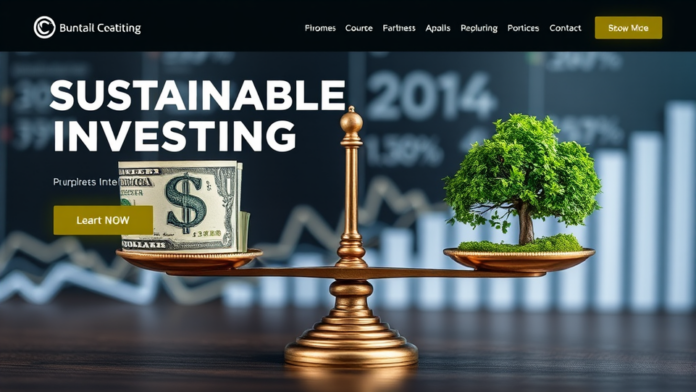Sustainable Investing: Balancing Profits and Environmental Impact
Definition and Importance
Sustainable investing refers to the integration of environmental, social, and governance (ESG) factors into investment decisions. This approach seeks to generate financial returns while promoting positive societal impact. Investors are increasingly recognizing that sustainable practices can enhance long-term profitability. It’s about more than just profits. Companies with strong ESG performance often exhibit lower risk profiles. This is crucial for informed decision-making. The growing demand for transparency in collective practices is reshaping investment landscapes. Are we ready for this shift? Sustainable investing aligns capital with values, fostering a more resilient economy.
Historical Context and Evolution
Sustainable investing has evolved significantly over the decades. Initially, it emerged from socially responsible investing (SRI) in the 1960s. Investors began to exclude companies involved in unethical practices. This was a pivotal moment. By the 1980s, the focus shifted towards integrating ESG factors into investment analysis. Notably, the 1992 Earth Summit catalyzed global awareness.
Key milestones include:
These developments reflect a growing recognition of sustainability’s financial relevance. The landscape is changing rapidly.
Understanding Environmental, Social, and Governance (ESG) Criteria
Components of ESG Criteria
ESG criteria encompass three key components: environmental, social, and governance factors. Environmental criteria assess a company’s impact on nature. This includes resource usage and waste management. Social criteria evaluate relationships with employees, suppliers, and communities. Strong social practices enhance brand loyalty. Governance criteria focus on corporate leadership and transparency. Effective governance fosters trust and accountability. These components are interconnected. They collectively influence long-term sustainability. Understanding them is essential for informed investment decisions.
Impact of ESG on Investment Decisions
The impact of ESG factors on investment decisions is increasingly significant. Investors are now prioritizing companies with strong ESG performance. This shift reflects a growing awareness of sustainability’s financial implications. Companies with robust ESG practices often experience lower volatility. They tend to attract more capital over time.
Key considerations include:
These elements are crucial for long-term success. Are you considering ESG in your investments?
Benefits of Sustainable Investing
Financial Performance and Returns
Sustainable investing can enhance financial performance and returns. Research indicates that companies with strong ESG practices often outperform their peers. This is due to better risk management and operational efficiencies. Investors may find that these companies are more resilient during market downturns.
Key factors include:
He should consider these aspects when evaluating investments. Sustainable choices can lead to better long-term outcomes.
Long-term Risk Mitigation
Sustainable investing plays a crucial role in long-term risk mitigation. Companies that prioritize ESG factors are often better equipped to handle regulatory changes. This proactive approach reduces potential liabilities. Additionally, they tend to have more resilient supply chains.
Key benefits include:
He should recognize these advantages when assessing investment opportunities. Sustainable strategies can safeguard against future uncertainties.
Challenges in Sustainable Investing
Greenwashing and Misleading Claims
Greenwashing poses significant challenges in sustainable investing. Companies may exaggerate their environmental initiatives to attract investors. This misrepresentation can lead to poor investment decisions. He must be cautious when evaluating claims.
Key issues include:
He should scrutinize ESG reports carefully. Accurate information is essential for informed choices.
Data Availability and Standardization Issues
Data availability and standardization issues complicate sustainable investing. Many companies lack consistent reporting on ESG metrics. This inconsistency makes comparisons challenging. He may struggle to assess true sustainability performance.
Key challenges include:
He should seek reliable data providers. Accurate and standardized information is vital for sound investment decisions.
Strategies for Sustainable Investment
Integrating ESG Factors into Investment Analysis
Integrating ESG factors into investment analysis enhances decision-making. He should evaluate companies based on their environmental impact, social responsibility, and governance practices. This comprehensive approach identifies potential risks and opportunities.
Key strategies include:
He must prioritize transparency in reporting. Effective integration of ESG factors can lead to more informed investment choices.
Active vs. Passive Sustainable Investment Approaches
Active and passive sustainable investment approaches offer distinct strategies. Active direction involves selecting individual securities based on ESG criteria. This method allows for tailored investment decisions. He may achieve higher returns through careful analysis.
In contrast, passive investing typically involves index funds that track ESG benchmarks. This approach provides broad market exposure with lower fees. He should consider the trade-offs between potential returns and management costs.
Both strategies have merit. Understanding their differences is essential for informed choices.
The Future of Sustainable Investing
Trends and Innovations in the Field
Trends and innovations are shaping the future of sustainable investing. Increasingly, investors are demanding greater transparency in ESG reporting. This shift encourages companies to adopt standardized metrics. He may find that improved data quality enhances decision-making.
Emerging technologies, such as artificial intelligence, are also playing a role. These tools can analyze vast amounts of ESG data quickly. Additionally, impact investing is gaining traction, focusing on measurable social benefits.
He should stay informed about these developments. Understanding trenfs is crucial for strategic investment planning.
Regulatory Developments and Their Implications
Regulatory developments are influencing sustainable investing significantly. New regulations require companies to disclose ESG-related risks. This transparency enhances accountability and investor confidence. He must be aware of these changes.
Key implications include:
He should monitor regulatory trends closely. Staying informed is essential for strategic planning.

